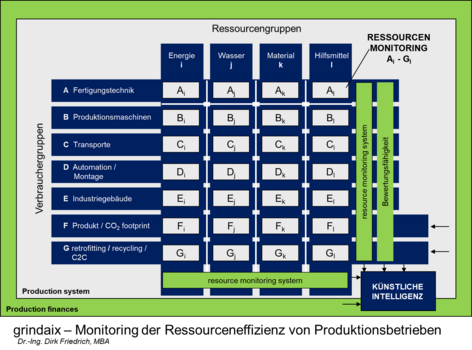Digitalisation enables resource-efficient production technology!
Interview with Dr. Ing. MBA Dirk Friedrich, CEO Grindaix
Editorial staff: Why is the demand for "resource-efficient production" increasing?
Dr. Friedrich: The increasing scarcity of resources, due to the consumption-driven global increase in demand for industrial production, is driving the prices of sought-after raw materials to such a high level that their relevance in the calculation of manufacturing costs has increased significantly. Both future taxation concepts with regard to the CO2 consumption of manufacturing companies and the increased environmental awareness of product users due to current climate changes will lead to a higher demand for products that are manufactured as "sustainably" as possible from an ecological point of view.
The pressure that manufacturing companies are under to reduce their production costs is also increasing steadily. In the past, low wage costs have usually been the most effective measure for reducing costs. This has led and in some cases still leads to the relocation of production sites to so-called "low-wage countries".
In the context of such increasing globalisation effects, German companies now produce worldwide and have the opportunity to use the different labour cost, investment, tax and other conditions in the various countries to the benefit of their company. Small and medium-sized companies operating nationally or alone in Europe, which initially did not have these possibilities, were often threatened in their existence by the competition from internationally operating competitors or similarly large production companies located in the new competitor countries.
However, the COVID-19 virus pandemic, which has been rampant since 2019, has shown the limits of globalisation. In some cases, there are calls for a preferential regional supply of production-relevant goods.
Thus, an essential question for the medium-sized, regionally operating production technology in Europe is indeed posed: How can one react to all these development trends from a technically oriented point of view in order to sustainably guarantee the profitability of "domestic" production, as one of the important pillars of the European economy?
Editorial staff: Weren't there already calls for ecologically sustainable production in the 1980s?
Dr. Friedrich: Certainly, model proposals for more ecological production have existed for many decades. They have already been published several times by environmental associations and ecologically oriented political parties and their implementation in practice has been demanded by legislative decree. But up to now, the monetary incentive for production companies has often not been given. In connection with environmental protection, it was understood that special expenditures should be made instead of, as is the case today, being able to reduce costs in the short term through ecologically oriented production management. Manufacturing companies are increasingly recognising that the efficient use of resources and operating materials is an effective lever for reducing manufacturing costs. However, this topic offers such a wide variety of possible approaches that manufacturing companies seem to find it difficult to find a structured approach in combination with a clear amortization concept.
Editorial staff: How can a manufacturing company act preventively in order not to have to react curatively when laws are binding in the short term?
Editorial staff: So if the more efficient consumption of resources in production plants plays such a significant role in reducing manufacturing costs, how do you measure and evaluate it?
Dr. Friedrich: In order to be able to evaluate and optimize a value chain with regard to resource efficiency, an evaluation capability must generally be created first. For this purpose, the individual consumptions of all relevant consumption systems in a production company must be identified and measured in real time, digitized if possible. It must be possible to define individual areas of consideration as system boundaries, thereby making it possible to differentiate clearly between them and analyse their contribution value. To guarantee this in parallel for all machines of a production system in real time exceeds human capabilities by far. Software-based assistance systems are indispensable for coping with such highly complex optimization processes. Such assistance systems are based on algorithms, which in turn require a sufficiently large amount of data, a standardized data structure and high quality across all measured variables of a company's existing machines in order to be able to make successfully implementable recommendations for action. All hardware components required for the digitization of existing machines and technical components are supplied and installed by team Grindaix!
As a result, system boundaries arise on the customer side, within which a clean balance of the consumption of operating resources can be made in real time. Even from today's point of view, the mere sensor-based collection of consumption data does not pose a major problem. The measurement technology offers here many practice-proven possibilities which merge into a whole in connection with the industry-compliant digitalisation technology of Grindaix. However, the quality of a measured value and the sustainability of a sensor accuracy is decisive for the quality of a software-based assistance system. Therefore not every sensor is suitable for every task. We provide experience-based advice on when and where which sensor is suitable and economically viable.
But there are also negative effects that should not be neglected. The technical risks that a change in an individual consumption parameter can entail are not sufficiently recorded. This means that the technological dependencies of the consumers among themselves are not sufficiently described. Here, too, software-based assistance systems with "predictive maintenance" functions can be used to help companies both to save CO2 and to ensure high machine productivity with consistent product quality.
In this context, the question inevitably arises as to who is responsible, for example, for reducing the cooling water consumption in a production machine without being able to concretely estimate how this will affect the process stability or even the service life of the production system. Due to the complexity of the cause-and-effect relationship, such uncertainties can only be eliminated with digitized auxiliary systems. As already mentioned, the essential maxim here is: "The higher the quality of the data with which such digital assistance systems are supplied, the higher is the informative quality of these".
We in team Grindaix see our task in collecting all relevant production data across all your existing machines in a professional manner and making it available at a central location in your company, secure against external access, in a standardised file format for further use (digital optimisation tools).
Editorial staff: How does the exemplary approach to get this complexity under control in a practical way work?
Dr. Friedrich: Within production technology, in addition to resources, there are different consumption groups that interact with each other in different ways in connection with the question of resource efficiency.
- Production technology (manufacturing processes)
- Production machines
- Transport systems
- Mounting systems
- Industrial building
- Products / CO2 footprint
- Retrofitting / Recycling / C2C
All seven consumption groups can be projected onto the four resource groups mentioned above. This initially results in 28 different observation areas Ai to Gl, as shown in Figure 1-1-1, for which a balance of resource use can be achieved.

Figure 1-1-1: Scopes for the Evaluation of a Resource-Efficient Production Technology
One of the main requirements in this context is the ability to present balances of resource flows within the individual observation areas and their technical interaction mechanisms in an integrative approach in a complete and practice-relevant manner.
As an example, a process sequence within the consumer group A - "production engineering" can be described as a sub-system to which resources such as energy in the form of electric current and valuable material flows such as water, component materials, for example steel, and auxiliary materials such as tooling materials, lubricating oils and cooling lubricants are supplied. The system is exited by finished components, scrap parts, carry-outs such as cooling lubricant residues on finished components, vapours of vaporised auxiliary and operating materials, chips, waste water and process-related waste heat. The goal of a company is to optimize the efficiency of a value-added chain within these consumer group-oriented system boundaries with regard to the various value streams (resource groups) without endangering the process capabilities of the entire value-added chain.
Editorial staff: If you want to analyze an entire production facility for its waste potential, how can this be achieved in practice?
Dr. Friedrich: First of all, we can only try to draw up a balance sheet for incoming and outgoing resource flows in the individual areas identified as relevant (Ai - Gl). In a second step, possible interactions due to a change in resource use between the observation areas are then described in terms of both intensity and reaction time. All observation areas use resources more or less efficiently to ensure profitable production technology.
In a second step, the question is answered: "How are the control and result variables of the individual observation areas recorded using information technology, so that the relevance of the individual observation areas with regard to the ecological efficiency and economic effectiveness of the overall system can be identified? From today's point of view, this can be solved most efficiently by means of a standardised digitisation technology on all production machines of a company, as offered by us in team grindaix. The investment costs are quite low. On average they are about 0.15 € per machine hour and machine, assuming that the technology is used 24 hours a day, 220 days a year, for example, for 10 years.
Provided that the customer has the consumption in all observation rooms measured digitally, it puts him in the advantageous position to get a clear overview of worthwhile starting points and to make intensive efforts not in less relevant observation rooms.
This shows that a singular and thus too facultative consideration of this challenge does not necessarily lead to the goal, but in extreme cases can even lead to unproductive results.
Sustainable success is much more likely to be achieved through a holistic approach. To master this approach, team Grindaix has developed the following guideline. The following measures can be carried out step by step and iteratively:
- Definition of the areas of consideration - Definition of the overall system
- Installation of a digitization package for recording consumption on all existing machines with a standardized data interface (OPC-UA) to software-based assistance systems.
- Identification of the individual influencing parameters in the observation rooms and their technical interaction options
- Assessment of the ecological and economic relevance of individual value flows in the areas under consideration
- Identification of the influence relevance of different observation areas
- Definition of suitable measures to optimize the resource efficiency in the overall system
- Stability assessment of the overall system of value creation in the event of changes in the use of resources in individual areas of influence using a technical and monetary interaction model (assessment of the identified measures for waste avoidance
- Concrete description of sustainable cost advantages (€/piece) through an integrative optimization of resource efficiency in production technology
The technical interactions between the individual viewing areas are the most important factors in deciding whether or not to decimate the use of resources.
"To recognize and correctly assess the mastery of such interactions is a very important technical differentiation of successfully operating companies of the future."
Dr. Friedrich: Exactly. Here, algorithms and software-based assistance systems will support us much more in order to master the complexity of interaction mechanisms within a production company. This very high level of technological understanding required here represents a unique selling point for companies that is quite resistant to substitution. It can be stored in algorithms and digitalized systems and train itself. Artificial intelligence will show us ways and opportunities that we did not consider possible. Industry 4.0 - that was yesterday. It is more than just using a few sensors. Digitization 1.0 is just starting today and the new challenges such as pandemics and the exceeding of ecological tipping-points will force us to deal more with the digitization of existing machines. So let's start today, before it is too late!
We in team Grindaix are ready to connect!
